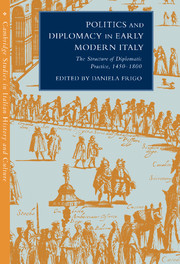Book contents
- Frontmatter
- Contents
- Introduction
- Diplomacy and government in the Italian city-states of the fifteenth century (Florence and Venice)
- Aspects of Medicean diplomacy in the sixteenth century
- An outline of Vatican diplomacy in the early modern age
- Economic and social aspects of the crisis of Venetian diplomacy in the seventeenth and eighteenth centuries
- ‘Small states’ and diplomacy: Mantua and Modena
- Neapolitan diplomacy in the eighteenth century: policy and the diplomatic apparatus
- Savoyard diplomacy in the eighteenth century (1684-1798)
- Index of names
- CAMBRIDGE STUDIES IN ITALIAN HISTORY AND CULTURE
An outline of Vatican diplomacy in the early modern age
Published online by Cambridge University Press: 29 October 2009
- Frontmatter
- Contents
- Introduction
- Diplomacy and government in the Italian city-states of the fifteenth century (Florence and Venice)
- Aspects of Medicean diplomacy in the sixteenth century
- An outline of Vatican diplomacy in the early modern age
- Economic and social aspects of the crisis of Venetian diplomacy in the seventeenth and eighteenth centuries
- ‘Small states’ and diplomacy: Mantua and Modena
- Neapolitan diplomacy in the eighteenth century: policy and the diplomatic apparatus
- Savoyard diplomacy in the eighteenth century (1684-1798)
- Index of names
- CAMBRIDGE STUDIES IN ITALIAN HISTORY AND CULTURE
Summary
INTRODUCTION
Throughout history, the question of the political representation of the Holy See has been a leitmotif of international affairs. But it was in the modern age that the diplomatic function acquired more definite form,structuring itself in accordance with the process of historical evolution that gave rise to homogeneous states organized on a dynastic–monarchical basis.
The question of pontifical representation had been current since the Middle Ages, and it began to grow urgent when the Papacy acquired territorial jurisdiction of its own. Diplomatic representation therefore acquired the outward guise of the expression of sovereignty. The continuity that one discerns in the transition from the Middle Ages to the modern age is precisely this search by the Holy See, in a changing historical context, for legal and political instruments with which to assert its sovereignty by means of effective diplomacy. The creation of an organizational apparatus for this purpose was an essential part of the ‘modernization’ of the Holy See. It has been claimed, indeed, that ‘as the modern State was being built, it permeated the Church and transformed even that nucleus of it deemed most impermeable, the Papacy’.
Papal diplomacy, therefore, was a factor in the ‘inadvertent’ constitution of the modern state through the figure of the nuncio, who must therefore be viewed in relation to the complex passage from the medieval to the modern age. There is no doubt that the papal nuncios came to play an increasingly decisive role in the Holy See's relations with other states, and in political relationships in general, until the Treaty of Westphalia. But it is equally indubitable that they were part of a more general and evangelical endeavour by the Church to transform human society.
- Type
- Chapter
- Information
- Politics and Diplomacy in Early Modern ItalyThe Structure of Diplomatic Practice, 1450–1800, pp. 95 - 108Publisher: Cambridge University PressPrint publication year: 2000
- 1
- Cited by



